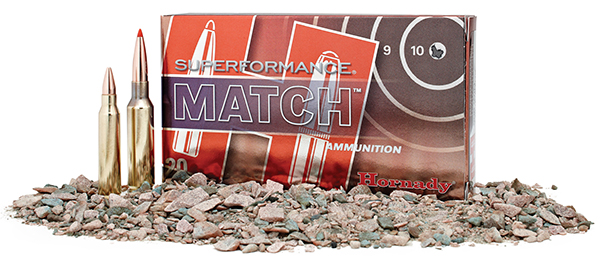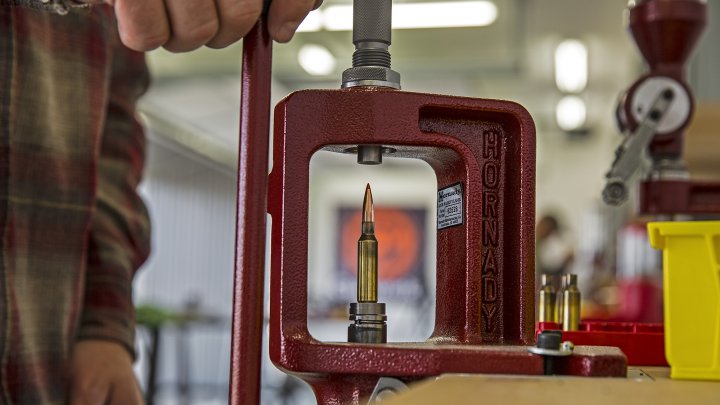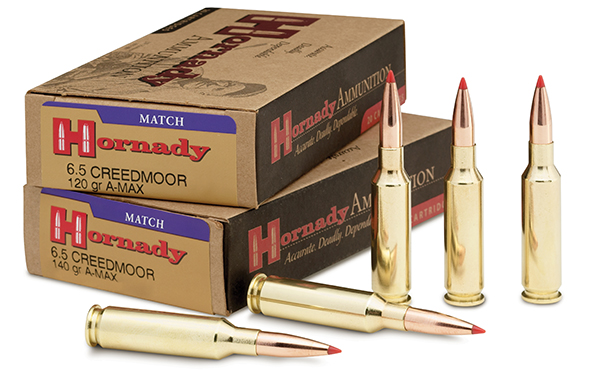Books, countless articles, video series and even classes have been devoted to the subject of long range shooting and the factory or hand loaded ammunition needed to achieve success. Many shooters can’t agree on what distance constitutes long range, much less the specific steps or equipment needed for that first-shot hit or to hold a tight group. While 600-yards is considered long range by many, others consider it mid-range. Specific to ammunition, disregarding shooter ability or rifle accuracy, we can easily consider 500-600 yards and further as long range. That distance is where we typically start to see variations in components or loading techniques affect the bullet’s point of impact or group size. Loads that may be acceptable at 300-yards may not have the consistency required for a 600-yard shot.

When you stretch the range out to 600 yards, that same 50 fps velocity variation is now 4.8-inches. That, coupled with the accuracy limitations of the rifle, can result in a miss on small targets. At 1,000 yards, the vertical string nears 20-inches. Even if the rifle is capable of shooting half-minute (5-inches at 1,000 yards) the combination of vertical stringing (19.9-inches) and rifle capability (5-inches) is over twice the size of the 10-inch bullseye used in 1,000-yard F-Class competitions. Obviously, velocity extreme variation (EV) is something we want to keep to a minimum.
Here are some considerations in minimizing EV and other ways to maximize the consistency and accuracy in ammunition for long range shooting.
Projectiles
The bullet itself is the foundation for accurate ammunition. Finding the best bullet for your particular firearm and barrel requires some trial and error. It is important to test these projectiles at longer ranges rather than relying on 100 or 200-yard accuracy.
For long range consistency, sort and remove bullets based on weight and length variations. Larger bullets (30-caliber and above) can withstand slightly more weight variation than smaller bullets. Bullet length is important as well for consistency. The best measurement is from the base to ogive location using a bullet comparator. Keep variation less than .005-inches.

Powders & Primers
Propellants, much like bullets, require some testing, and trial and error for finding the best results. Finer grained powders tend to meter the easiest. Where shorter distances (300-yards and in) are minimally affected by .3 grains in variation, long range shooting requires the variation to be as low as possible. Hand weighing each charge is beneficial.
Consistency requires the least amount of temperature sensitivity. Single base propellants (nitrocellulose) have significantly less performance variation with temperature fluctuation than double base (nitrocellulose plus nitroglycerin) powders. This is important if you expect to shoot in different climates. Examples of single base powders include IMR, Hodgdon and Vihtavuori 100 series.
Keep in mind that accuracy is more important than speed at long range. Don’t give up consistency to gain an extra 40 fps. Propellants with faster burn rates for the cartridge you are loading tend to produce better accuracy.
Like projectiles and propellants, experiment with different primers. Avoid using magnum primers unless you are shooting a magnum. Magnum primers provide a more violent ignition, which in non-magnum cases increases inconsistency.
Chronographs
Getting a true muzzle velocity for a cartridge with a chronograph can be a challenge. Outdoor lighting conditions constantly change and the slightest variation in the angle of the sensors can give you an incorrect velocity reading. An incorrect muzzle velocity reading can make it difficult to hit a long range target.
One of the best ways to get the actual muzzle velocity of your favored round is to do a trajectory validation in the field or at the shooting range. Many ballistic calculators have an option for determining your muzzle velocity. By providing a ballistic coefficient and true sight-in range, then shooting at a further distance and measuring the drop from point-of-aim, an accurate muzzle velocity can be calculated. Trajectory validations can help you determine an accurate muzzle velocity or BC of your projectile. See our article, Qualifying A Long Range Rifle, for more on this topic.
Perhaps the best function of a chronograph is comparing one load to another and measuring velocity extreme variation. Keep working on your loads to get your EV down to 25-35 fps or less. Single digit EV’s are obtainable when everything (cartridge, chamber, barrel etc.) is perfect.
Cartridge Cases
Cartridge cases are important as they bring all the components together. Weight and capacity vary from one manufacturer to another. Sorting cases by manufacturer is beneficial and even keeping cases separated by manufacturing lot adds to consistency. Separating cases by the number of times they’ve been fired is also recommended.
For long range consistency, sort cases in 1-grain weight increments. Deburr flash holes and ensure that primer pocket depths are uniform. This helps provide a more even primer ignition and flash.

Some shooters find success in building tight chambers and turning (removing brass from) the necks of their cartridge cases down to fit.
Reloading Die Sets
When hand loading or reloading, there are specific steps and equipment that can help maximize consistency and accuracy.
When a cartridge is fired, it expands to the walls of the chamber. When reloading that cartridge case, you have the option of resizing the whole case back to its original size, or simply sizing the neck down and leaving the body the size of your chamber. Consistency can be gained with leaving the case body the size of the rifle it was fired in. Much like case neck consistency, if the case body expands and touches one side of the chamber first, rather than contacting all sides evenly, it can lead to inconsistency. Leaving the case body the size of the chamber minimizes this. Of course, there are limitations to neck sizing. You only want to use neck-sized ammunition in the gun it was originally fired in. Also, it is not recommended in semi-autos as it can lead to feeding issues. Neck sizing without pushing the case shoulder back can make it difficult to close the bolt. The best scenario is using a shoulder bump die to neck size and bump the shoulder back for correct headspace.
Using die sets that feature a floating style seating stem can help ensure that the bullet is seated straight in the cartridge case. When a bullet is not seated straight, you can visually see a wobble in the bullet when rolling the cartridge on a hard surface. The wobble, or run-out, can affect the accuracy of the load. Run-out should be kept below .004-inches for long range shooting. It is also helpful to use seating stems that match the profile of the bullet you are using.
Cartridge Overall Length (C.O.L.)
When seating bullets, experiment with various jumps to the lands (where the rifling starts in your barrel) to establish the best accuracy load. Using effective tools can help in this process immensely. Typically, a short jump of .000-.003-inches provides the best accuracy. Long range bullets typically have long ogives which tend to shoot best seated on or into the rifling.
Remember that measuring to the ogive is a more consistent measurement than measuring to the bullet tip.
Factory Ammunition
Improving on factory ammunition by hand loading is not as easy as it once was. Factory match loads can provide extremely good consistency. Some factory loads can also reach velocities using proprietary powder blends that hand loaders cannot achieve with off-the-shelf propellants within established pressure limits.
Shooters who either lack the time for hand loading, or don’t wish to invest in the equipment have viable alternatives with factory match ammunition in a variety of popular calibers.
Editor’s Note:
We’d like to thank Aaron and Gunwerks for allowing us to re-publish this article. If you’re interested in long range ballistics, shooting and science the Gunwerks site is an invaluable resource. Find more articles like this at www.gunwerks.com.

